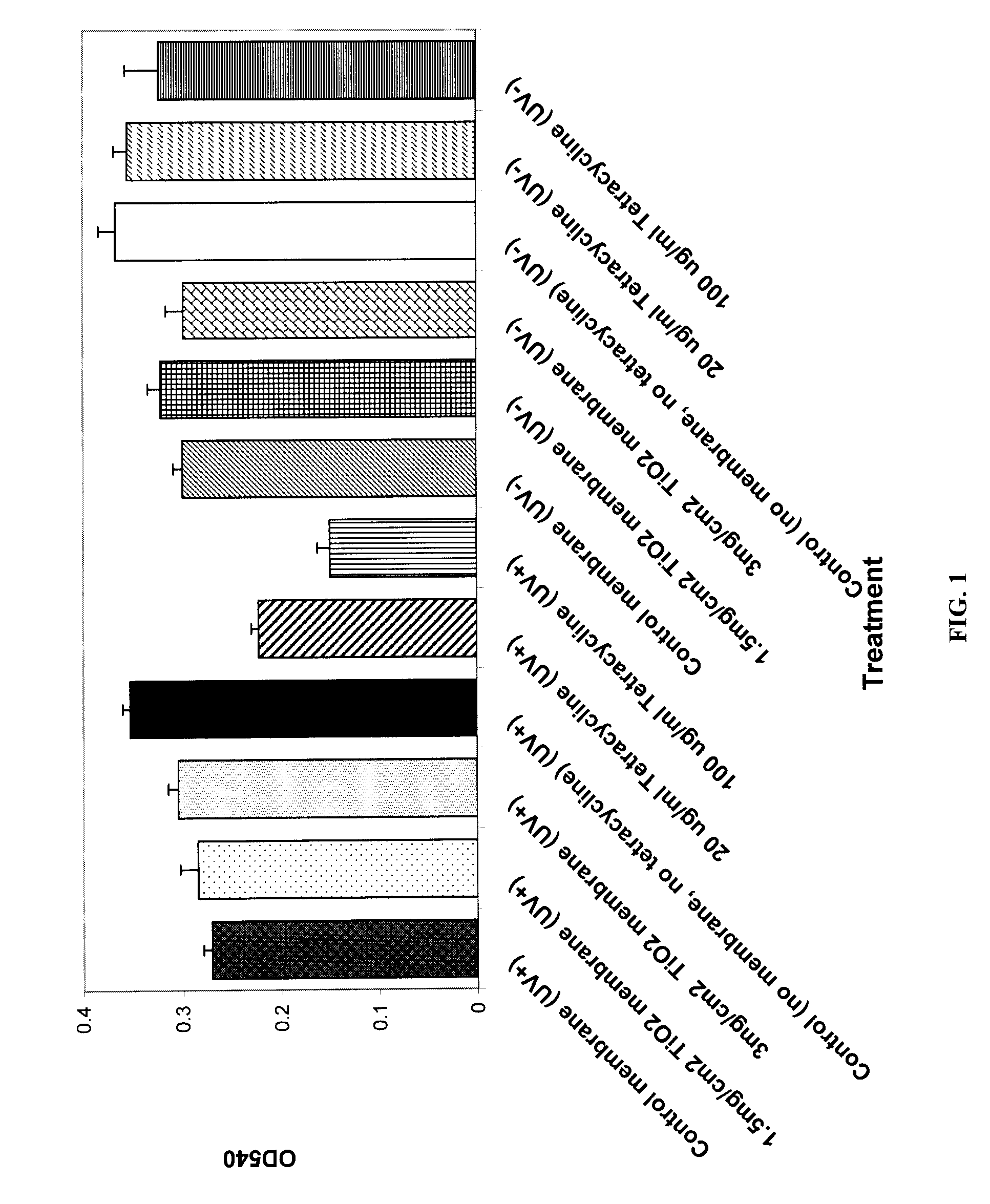Photoactivated Antimicrobial Wound Dressing and Method Relating Thereto
a photoactivated, wound dressing technology, applied in the direction of dressings, bandages, physical/chemical process catalysts, etc., can solve the problems of prolonging the healing time and treatment costs, serious, sometimes life-threatening complications, and affecting the healing effect of the wound
- Summary
- Abstract
- Description
- Claims
- Application Information
AI Technical Summary
Problems solved by technology
Method used
Image
Examples
example 1
Growth of Bacterial Cellulose Membranes
[0036]The cellulose membranes are prepared by cultivation of cellulose-producing bacteria of the species Gluconacetobacter hansenii or Gluconacetobacter xylinus (synonyms Acetobacter xylinus, Gluconoacetobacter xylinus, Gluconoacetobacter hansenii), or a combination of the two species. The bacteria are cultivated under static conditions in rich media formulations or with an improved synthetic medium. For cellulose production, precultures of the bacteria are diluted ten-fold with fresh media. Culture is carried out at a temperature of 28-30° C. by adding an aliquot of activated seed broth to the culture medium (Iguchi2000). As observed in earlier studies, the cellulose pellicule begins to form at the surface of the media and its thickness increases with time. Culture dishes of 6 or 9 cm diameter are used for cellulose production. In the process of gel growth, the aerobic bacteria generate cellulose only in the vicinity of the surface, so that pr...
example 2
Infiltration
[0038]Nanosized crystalline (anatase form) TiO2 of two grades was obtained from Alfa Aesar. The first grade had a particle size of 32 nm with a surface area of 45 m2 / g and the second grade had a particle size of 5 nm with a surface area of 200-220 m2 / g. Since the photocatalytic activity increases with surface area, Grade 2 TiO2 particles were expected to be more effective than Grade 1. A dispersion of crystalline TiO2 particles with a concentration of 1 mg / ml was prepared by suspending 100 mg of crystalline TiO2 in 100 ml dilute nitric acid solution (0.075M). The dispersion was sonicated in an ultrasonic bath for 10 minutes prior to incorporation to ensure that the crystalline TiO2 particles were well dispersed and thus forming a TiO2 suspension.
[0039]The cleaned bacterial cellulose (BC) membranes (9 cm in diameter) were placed in a vacuum filtration unit with a 90 mm diameter PES membrane. For a loading of ˜1.5 mg / cm2 on one side, approximately 100 ml of the TiO2 suspen...
example 3
Photocatalytic Activity
[0042]The photocatalytic activity of the membranes of Example 2 was tested under UV illumination using the oxidation of a Procion Red Dye as a model reaction. The membranes were partially dried in a gel dryer to increase the cellulose content to 5-6% by weight. When the membranes were in contact with the dye and exposed to UV illumination with maximum emission at approximately 365 nm, photocatalytic oxidation was observed and resulted in reduced absorbance from the dye at a wavelength of 540 nm. A minimum intensity of 2000 μW / cm2 as measured by a UVP J221 meter is needed to activate the membranes. The time of exposure ranged from 5 minutes to 120 minutes.
PUM
| Property | Measurement | Unit |
|---|---|---|
| particle size | aaaaa | aaaaa |
| wavelength | aaaaa | aaaaa |
| wavelength | aaaaa | aaaaa |
Abstract
Description
Claims
Application Information
 Login to View More
Login to View More - R&D
- Intellectual Property
- Life Sciences
- Materials
- Tech Scout
- Unparalleled Data Quality
- Higher Quality Content
- 60% Fewer Hallucinations
Browse by: Latest US Patents, China's latest patents, Technical Efficacy Thesaurus, Application Domain, Technology Topic, Popular Technical Reports.
© 2025 PatSnap. All rights reserved.Legal|Privacy policy|Modern Slavery Act Transparency Statement|Sitemap|About US| Contact US: help@patsnap.com


